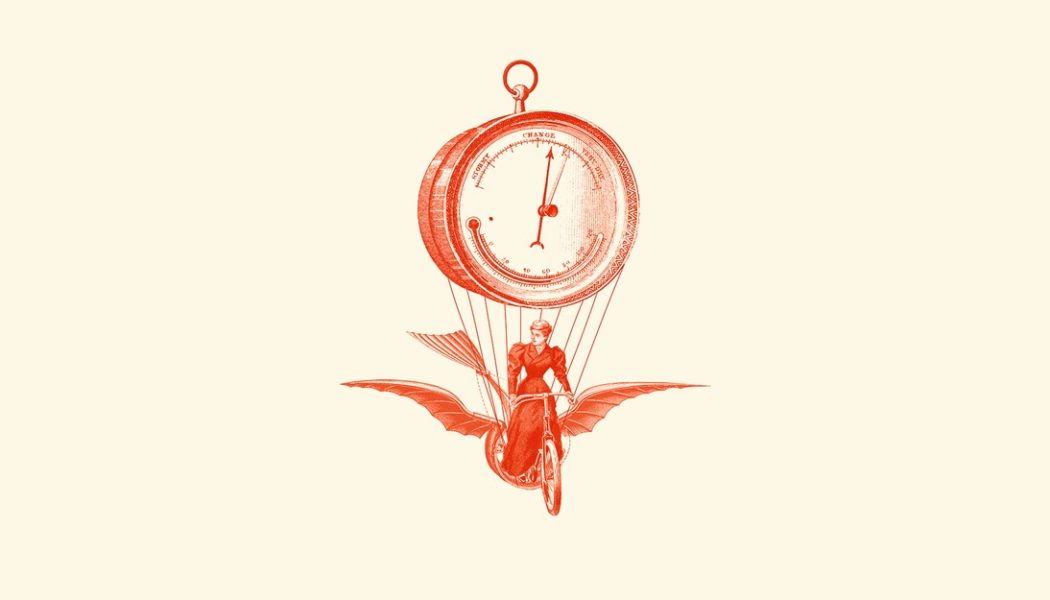
This is an edition of Time-Travel Thursdays, a journey through The Atlantic’s archives to contextualize the present, surface delightful treasures, and examine the American idea. Sign up here.
Human excellence can take many forms—electric-guitar solos, French braiding, organic chemistry, and the throwing of pizza dough all come to mind—but when it comes to predicting the future, our species is basically an embarrassment. People tend to have little self-awareness about the blinkers of their own presentism. They fear change. They are generally terrible at accurately determining risk. And their views are too often driven by emotion rather than empiricism or even well-informed instinct.
A slightly more charitable assessment is that people actually are good at predicting the future—just less good at predicting when and how any particular future will finally arrive. (The famous shorthand for this mismatch: “Where’s my jetpack?”) The passage of time has meant the emergence of an unintended genre of film and television that underscores this incongruity, in which past depictions of far-off futures are eventually revealed as off base. (Think Back to the Future II’s vision of 2015, filmed in the 1980s, now quickly receding into the past. Or any number of episodes of the original Twilight Zone.)
One of the many things I love about The Atlantic, now in its 167th year of continuous publication, is that our archive is filled with centuries’ worth of imagined futures—the ones that materialized and those that very much did not (or at least haven’t yet). Our newest newsletter, Time-Travel Thursdays, is a portal to these many past possible futures. Some weeks, we’ll share one great story from the vault. Other weeks, we’ll excavate a long-lost debate, mystery, or scandal, or trace the trajectory of a big idea across time.
Over many generations, our writers have made predictions about, among other things, the impecuniosity of the American railways (1860); the decline of the novel (1874); the worsening of the wealth gap (1879); the wholesale replacement of human workers with machines (also 1879); the rise of modern meteorology (1880); the use of electricity to transmit photographs over great distances (1882); the creation of audio books (1889); the end of musical criticism (1903); the need to affix airplane-landing docks to America’s skyscrapers (1921); and, conversely, the belief that air travel would never be adopted by the masses (1928). In our pages people have mused about whether Paris would become “a halfhearted and second-rate New York” (1929); the future of super-guerrilla warfare (1936); the “infinite faith in the future” required to fight against dictators for the future of democracy (1941); and the question of whether and how all life on Earth might be eliminated (1951). Atlantic writers predicted the hyperlinked architecture of the web (1945), and advances in surgery that would make spare-parts banks for human organs as commonplace as auto-supply stores (1980). They have also suggested that someday soon everything will be made of chickpeas (2019).
Among the many considerations Atlantic writers have given to the future, an old favorite of mine is the 1861 essay “Concerning Future Years,” by the Scottish writer A. K. H. Boyd, who urges the reader to appreciate the precious and finite quality of their “one life, the slender line of blood passing into and passing out of one human heart.” In doing so, he contemplates the future not in terms of technological, political, or civilizational change, but on a simultaneously more intimate and universal level. (As was The Atlantic’s style at the time, the essay does not actually carry his byline, but Boyd is listed as the author in various accounts and indexes.)
“Concerning Future Years” feels remarkably contemporary more than 160 years after it was first published. Boyd sees the future as something that an individual moves through time to reach, inextricably tied to the experience of living. He cautions against taking for granted even the most ordinary of life’s pleasures—the climbing of trees, the taking of walks, the presence of a child making daisy chains. “In this world there is no standing still,” he writes. “And everything that belongs entirely to this world, its interests and occupations, is going on towards a conclusion. It will all come to an end … Many men of an anxious turn are so eagerly concerned in providing for the future, that they hardly remark the blessings of the present. Yet it is only because the future will some day be present, that it deserves any thought at all.”
I’m drawn to Boyd’s essay, 19th-century lilt and all, in part because I am a sap when it comes to earnest acknowledgments of the good luck we are given with every new second of every new day—but also because it orients the reader toward the reason for the cultural obsession with time travel in the first place, a preoccupation that I share: that is, we are all time travelers, moving through our lives and through history, bearing witness to forces of tremendous change much greater than we are, mostly oblivious to the malleable quality of time even as it bends around us, far more connected to the individuals who came before us than we sometimes realize. When you stop to contemplate the sweep of what’s changed, and study the history of ideas, you inevitably find a connection through time—and perhaps through the pages of a very old magazine—to the travelers who have come before. And in doing this you will find you are sometimes lucky enough to receive unexpected wisdom and insight from another age. Or at the very least, a swell of gratitude for the people and world around you, just as they are right now.









